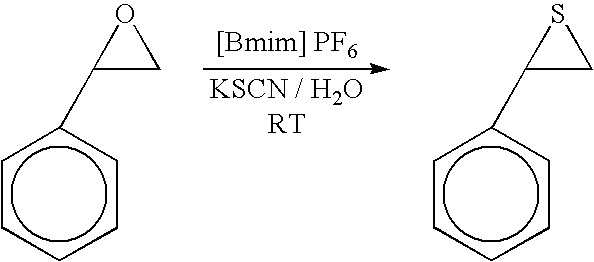Synthesis of cyclic trithiocarbonates from epoxides
a technology of cyclic trithiocarbonates and epoxides, applied in the field of synthesis of cyclic trithiocarbonates from epoxides, can solve the problems of low yield of desired cyclic trithiocarbonates, low cost, and relatively few methods available for the preparation of substituted cyclic trithiocarbonate derivatives
- Summary
- Abstract
- Description
- Claims
- Application Information
AI Technical Summary
Benefits of technology
Problems solved by technology
Method used
Image
Examples
example 1
[0031]In this experiment styrene oxide which is readily available at low cost was convert to 4-phenyl-1,3-dithiolane-2-thione by utilizing the process of this invention. The reaction was carried out as a one step process which can be depicted as follows:
[0032]
[0033]In the procedure used in this experiment a 500 ml 3-neck round bottom flask equipped with a magnetic stir bar, nitrogen inlet, pot thermometer, condenser and heating mantle was charged with 100 grams of ionic liquid (1-butyl-3-methylimidazolium hexafluorophosphate), 24.0 grams (0.20 moles) of styrene oxide, 20.0 grams (˜0.20 moles) of potassium thiocyanate (KSCN), 25.0 grams of water, and 60 grams (0.79 moles) of carbon disulfide. The system was flushed with a slow purge of nitrogen and warmed to a temperature of about 30–35° C. At this point, a slow exotherm began to build and the color of the solution rapidly becames red-orange. The tempertaure of the reaction mixture was held at about 46° C. (the carbon disulfide reflu...
example 2
[0034]The recycled ionic liquid from Example 1 (about 96 grams) was recharged to the reaction vessel as before with the identical amounts of the other reagents. The reaction was otherwise run in an identical manner to the procedure used in Example 1. After isolation and recrystalliztion 20.6 grams of the product were recovered.
example 3
[0035]The recycled ionic liquid from Example 2 was recharged into the reaction vessel as before with the identical amounts of the other reagents. The reaction was run in an identical manner to the procedure used in Example 1 and Example 2. After isolation and recrystalliztion 24.8 grams of the product were recovered. The recovered filtrate was reduced by about 50% in volume to recover a second crop of crystalline product (20 grams).
[0036]In total, about 88.6 grams (0.418 moles) of recrystallized product was obtained from 0.60 moles of styrene oxide which represents a yield of 69.7%. After the three cycles a total of 84.5 grams of the ionic liquid was recovered. Losses of the ionic liquid probably represent typical handling losses when working at this scale.
PUM
| Property | Measurement | Unit |
|---|---|---|
| temperature | aaaaa | aaaaa |
| temperature | aaaaa | aaaaa |
| temperature | aaaaa | aaaaa |
Abstract
Description
Claims
Application Information
 Login to View More
Login to View More - R&D
- Intellectual Property
- Life Sciences
- Materials
- Tech Scout
- Unparalleled Data Quality
- Higher Quality Content
- 60% Fewer Hallucinations
Browse by: Latest US Patents, China's latest patents, Technical Efficacy Thesaurus, Application Domain, Technology Topic, Popular Technical Reports.
© 2025 PatSnap. All rights reserved.Legal|Privacy policy|Modern Slavery Act Transparency Statement|Sitemap|About US| Contact US: help@patsnap.com



